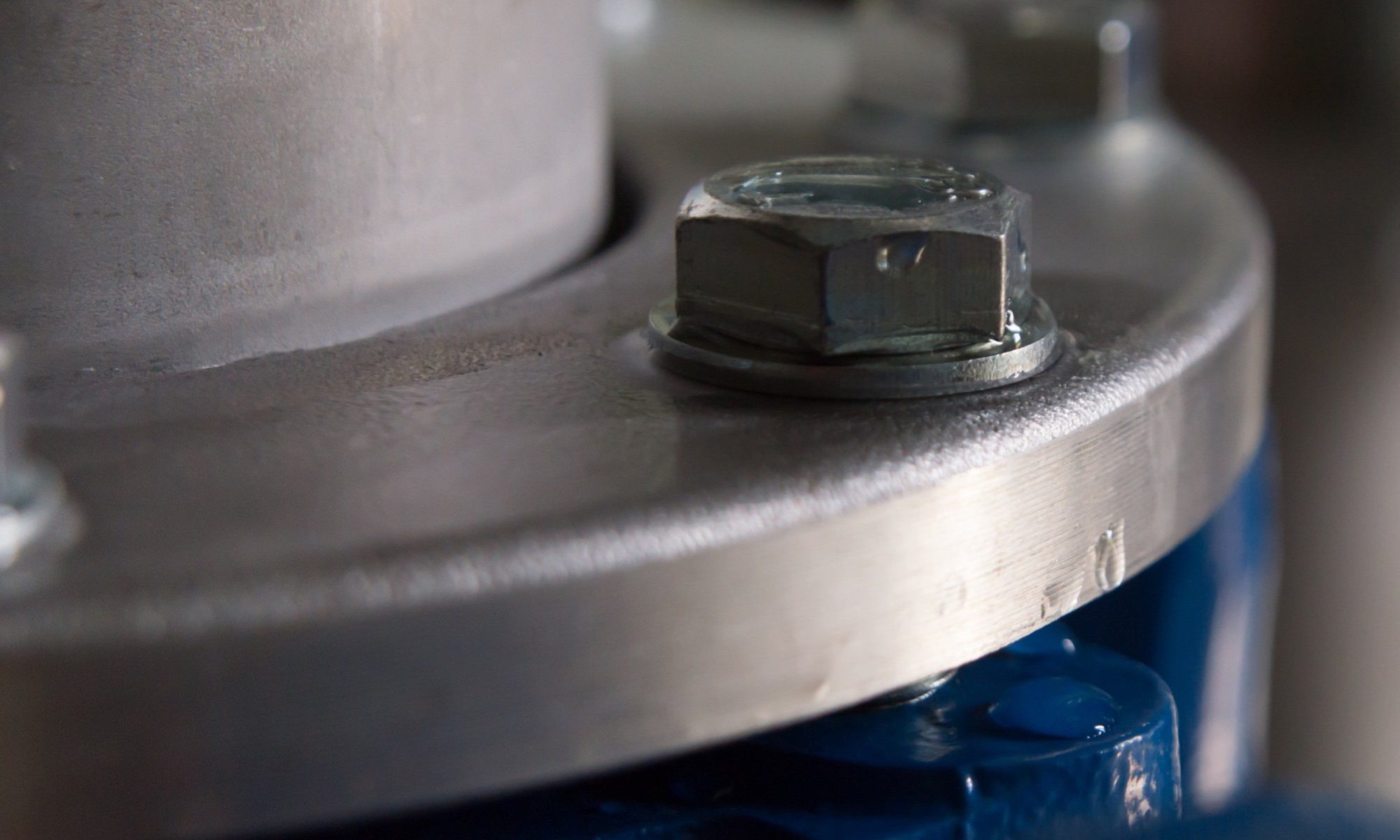There are two major categories of standards for Stainless Steel (SS) Threaded Pipe Fittings. The first defines the dimensions and the second defines the material. Both are important for consistent quality and fit. The standards in this report are used primarily in the USA. The three most trusted organizations tasked with writing pipe fitting standards are ASTM, ANSI and ISO.
ASTM – American Society of the International Association for Testing and Materials
ANSI – American National Standards Institute
ISO – International Organization for Standardization.
Additional standards organizations
MSS – Manufacturers Standardization Society has further built upon the standards written by ASTM, ANSI and ISO by filling gaps and writing more detailed definitions and requirements.
ASME pipe fitting standards are compiled from these organization’s standards.
Class 150 SS threaded fitting specifications should include the following.
Defined Connections
Defined Pressure Class
Defined Material Type
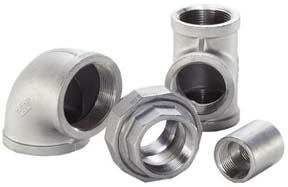
Connections
SS threaded fittings are readily available in the US in sizes from 1/8” to 4” NPT (National Pipe Thread Taper.)
ANSI B1.20.1 defines the thread dimensions and tolerances.
When specifying fittings, it is import to include ANSI B1.20.1 to insure all the connections are the same size and shape. A tight, well fit connection will help prevent the most common cause of leaks.

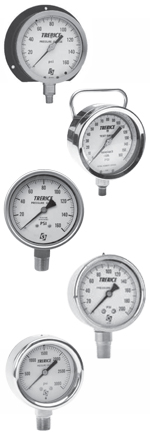
Pressure Class
The working pressure of a fitting will be limited by the material type and the thickness. Thicker cast fittings can sustain higher pressures. But a forging can sustain higher pressures than a casting of equal thickness. Generally speaking, the higher the pressure class the thicker the fitting. Dimensional standards and tolerances are used to define the pressure class (see the next section.)
Threaded SS pipe fittings are readily available in Class 150, 1000, 2000, 3000, 6000 and 9000. It is important to note that the pressure class does not represent the actual allowable working pressure. For critical applications, please consult a qualified engineer to determine the proper material and pressure class.
Pipe fittings, flanges and valves are classified by their pressure class. Unfortunately the actual working pressures will vary between these products with the same pressure class. For example, a class 150 threaded fitting has different working pressures and pressure limits than a class 150 valve or a class 150 flange.
All piping product pressure limits will vary based on internal and external temperatures. So a Class 150 fitting may have a maximum working pressure of 200 PSI at 70 deg F. But as the temperature increases, that maximum working pressure will decrease.
Class 150 Fitting Dimensional Standards
Class 150 SS fittings are made to several different dimensional standards and have a wide variable in quality and construction. Threaded fittings are available with the following standards.
1) No standard – these are probably fine for the fountain in your fish pond.
2) ISO 4144 – these are relatively thin, low cost fittings
3) ISO 49-1983 (E) – this standard was originally written for iron fittings. It was adopted at a time when no other SS fitting standard was available. These are thicker than the ISO 4144 and still very common today.
4) ANSI B16.3 - this standard was originally written for iron fittings. It was adopted by a few US manufacturers at a time when no other SS fitting standard was available.
5) MSS SP-114 – this was the first standard specifically written for class 150 SS fittings. It is based on ANSI B16.3 dimensions with further requirements. This is the most comprehensive standard used today.
Please contact the listed organization for specific dimensions and tolerances.
Final note on dimensions
SS fittings have been mass produced since the early 1940’s. This was 50 years before any standards (MSS SP-114) were written. Most manufacturers’ from around the world designed and produced their fittings to match iron, brass or steel fitting norms. In order to cut cost, many did not, opting to build their own designs. Some of these designs are suitable for fish ponds while others became entrenched and are still used today.
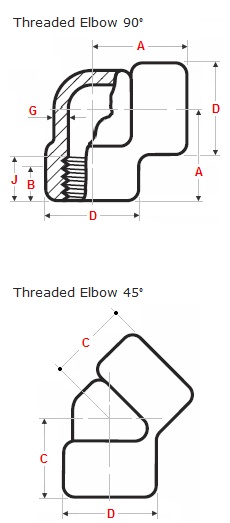
Material Standards
Stainless Steel is produced in many different grades, each with its own unique chemical and mechanical properties. There are two commonly produced material grades (often referred to as “type”) available in SS Class 150 threaded fittings, 304 and 316. These are “on the shelf” items in every major metropolitan area in North America. “L” grades are not readily available in cast fittings.
Cast stainless steel pipe fittings should meet the ASTM A351 standard. The two material grades are CF8 (304) and CF8M (316.) CF8 and CF8M are the correct designations for cast stainless grades, however type 304 and 316 are commonly used in lieu of these designations.
Most Class 150 fittings are cast, although some bushings, caps, plugs and couplings are made from ASTM A182 or A276 bar stock. In nearly every application the bar stock fitting is better than the cast.
Fitting Shapes, Configurations and Descriptions
Manufacturers vary in the shapes that each produces. Some only produce a few shapes and sizes. I am not aware of a single manufacturer that produces all the shapes and sizes in all the different standards and grades.
This is a list of Class 150 1/8” - 4” SS fitting configuration descriptions. Please note not all configurations are available in all pipe sizes.
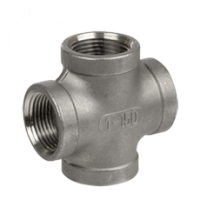

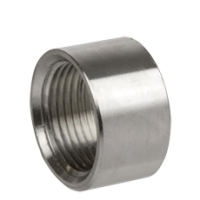
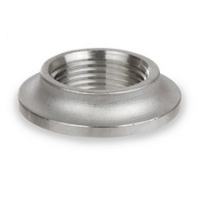
45 degree elbow - FNPT x FNPT
45 degree lateral - FNPT x FNPT x FNPT
45 degree street elbow - FNPT x MNPT
90 degree elbow - FNPT x FNPT
90 degree street elbow - FNPT x MNPT
Cap - FNPT
Countersunk Hex Plug - MNPT
Cross - FNPT x FNPT x FNPT x FNPT
Full Coupling - FNPT x FNPT
Half Coupling - FNPT
Hex Bushing - MNPT x FNPT
Hex Nipple - MNPT x MNPT
Hex Head Plug - MNPT
Locknut - FNPS
Reducing Coupling - FNPT x FNPT
Spud/Tank Flange - FNPT
Square Head Plug - MNPT
Tee - FNPT x FNPT x FNPT
True Wye - FNPT x FNPT x FNPT
Union - FNPT x FNPT
Putting it all together
A complete specification should include the following.
1) The range of pipe sizes
2) The thread specification (ANSI B1.20.1)
3) The pressure class specification (ISO 4144, ISO 49-1983 (E), ANSI B16.3 or MSS SP-114)
4) The material specification (ASTM A351/A182/A276 grade CF8 or grade CF8M)
Stainless Steel Fittings
Class 150 fittings shall meet MSS SP-114 standards for sizes 1/8” thru 4”. Threads shall meet ANSI B1.20.1. Material is ASTM A351 grade CF8M or ASTM A182 grade 316 or ASTM A276 grade 316.
The difference between failure and success is doing a thing nearly right and doing it exactly right.
Edward Simmons
I have always wanted to be somebody, but I see now I should have been more specific.
Lily Tomlin
Most stainless piping applications are for sanitary or corrosion resistance. These are usually critical applications. Building and maintaining a trouble free piping system requires specifying and installing the right products for your application.
Stainless steel fittings are built to a variety of specifications. Make sure you get the correct fittings by including a complete description on all your piping products.
Make sure you specify quality fittings.
You can download a copy of this here. How to Specify Class 150 SS Fittings
“The Complete Piping Package”
Contact us:
Hayward Pipe & Supply Co., Inc
3218 Diablo Ave
Hayward, CA, 94545
510-887-2700
sales@haywardpipe.com

